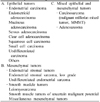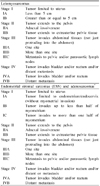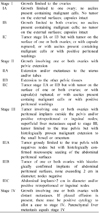1. Pecorelli S, Zigliani L, Odicino F. Revised FIGO staging for carcinoma of the cervix. Int J Gynaecol Obstet. 2009. 105:107–108.
2. Hricak H, Gatsonis C, Coakley FV, Snyder B, Reinhold C, Schwartz LH, et al. Early invasive cervical cancer: CT and MR imaging in preoperative evaluation - ACRIN/GOG comparative study of diagnostic performance and interobserver variability. Radiology. 2007. 245:491–498.
3. Hong JH, Tsai CS, Lai CH, Chang TC, Wang CC, Chou HH, et al. Risk stratification of patients with advanced squamous cell carcinoma of cervix treated by radiotherapy alone. Int J Radiat Oncol Biol Phys. 2005. 63:492–499.
4. Horn LC, Fischer U, Raptis G, Bilek K, Hentschel B. Tumor size is of prognostic value in surgically treated FIGO stage II cervical cancer. Gynecol Oncol. 2007. 107:310–315.
5. Creasman W. Revised FIGO staging for carcinoma of the endometrium. Int J Gynaecol Obstet. 2009. 105:109.
6. Pecorelli S. Revised FIGO staging for carcinoma of the vulva, cervix, and endometrium. Int J Gynaecol Obstet. 2009. 105:103–104.
7. Prat J. FIGO staging for uterine sarcomas. Int J Gynaecol Obstet. 2009. 104:177–178.
8. Horn LC, Schmidt D, Fathke C, Ulrich U. New FIGO staging for uterine sarcomas. Pathologe. 2009. 30:302–303.
9. Homesley HD, Bundy BN, Sedlis A, Yordan E, Berek JS, Jahshan A, et al. Assessment of current International Federation of Gynecology and Obstetrics staging of vulvar carcinoma relative to prognostic factors for survival (a Gynecologic Oncology Group study). Am J Obstet Gynecol. 1991. 164:997–1003. discussion-4.
10. Tantipalakorn C, Robertson G, Marsden DE, Gebski V, Hacker NF. Outcome and patterns of recurrence for International Federation of Gynecology and Obstetrics (FIGO) stages I and II squamous cell vulvar cancer. Obstet Gynecol. 2009. 113:895–901.
11. Fons G, Hyde SE, Buist MR, Schilthuis MS, Grant P, Burger MP, et al. Prognostic value of bilateral positive nodes in squamous cell cancer of the vulva. Int J Gynecol Cancer. 2009. 19:1276–1280.
12. Kohorn EI. The new FIGO 2000 staging and risk factor scoring system for gestational trophoblastic disease: description and critical assessment. Int J Gynecol Cancer. 2001. 11:73–77.













 PDF
PDF ePub
ePub Citation
Citation Print
Print









 XML Download
XML Download